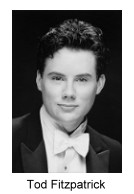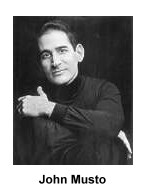|
These words opened the faculty recital by coloratura soprano Lauren
Fowler on Sunday evening November 4 in the Gaines Theatre of Christopher
Newport University. The audience enjoyed a versatile showcase of Dr.
Fowler's varied musical talent, ranging from very early Italian art
songs to contemporary jazz songs. The program began with three selections
from a collection titled Twenty-Six Italian Songs and Arias.
The first song was Amarilli mia bella composed by Giulio Caccini
(1551-1618) who was a celebrated tenor and instrumentalist at the Medici
court. You can hear Amarilli on a CD, Live in Italy, sung
by Cicilia Bartoli, who very nicely and authentically ornaments the
musical line. Dr. Fowler chose to ornament the lines in a different
and no less interesting way. Also impressive were her trills in this
song and Che fiero costume by Giovanni Legrenzi (1626-1690) and
Tu lo sai by Giuseppi Torelli (1658-1709).
Moving forward 150 years we were presented Cinq melodies 'de Venise'
by Gabriel Fauré (1845-1924): Mandoline, En sourdine,
Green, A Clymème and C'est l'extase. Here
the singer captured the French idiom, demonstrating the contrast between
these two historic periods in art song. Charles Woodward's collaboration
on piano was just right for both eras. An unusual feature was the use
of gesture, even pantomime in presenting the mood and meaning of the
text.
Richard Strauss' Brentano Lieder, Op. 68 closed the first half.
As the vocal lines of Säusle, liebe Myrthe, Ich wollt' ein Straußlein
binden and Amor flowed out, this writer became aware of the
physicality of singing Strauss through the use of the singer's whole
body for dramatic interpretation. Lauren Fowler caught just right the
bittersweet tone of the second selection and the devilish delight of
love in the third.
As the sound died away the audience applauded loudly and long. Our
singer, dressed in a floor-length green taffeta gown, bowed. Her golden
hair and sweet smile left a lingering impression. This was in stark
contrast to the visuals on stage as the second half began. In a black
knee-length cocktail dress with microphone in hand and flanked by local
jazz trumpet luminary William Brown, Harris Simon, piano, James Masters,
bass, and Howard Curtis, drums, she launched into Thelonius Monk's Rhythm-a-ning.
The song opens with a call and response between singer and trumpet,
then moves into accompaniment with the whole band. The audience was
very enthusiastic as the song ended.
Taking time to introduce the musicians, Dr. Fowler followed with Amber
Tones (a tribute to the life and times of Chet Baker), composed
by William Brown and Steven Breese, from a recent and very successful
production of Shakespeare's A Midsummer Night's Dream. Here our
vocalist showed her agility in scat singing, accompanied only by trumpet
and bass. Very exicting music making.
The vocal tone mellowed down to a purr on the line When I fall
in love from the Heyman/Young standard, caressing the words in a
controlled sensous emotional way.
The recital closed with Come Rain or Come Shine by Mercer/Arlen.
Throughout the jazz set Lauren Fowler maintained a digified looseness,
the microphone in her hand became an instrument. The writer was impressed
by her generosity in sharing the stage by showcasing each instrumentalist.
A celebration all the way.
Tod Fitzpatrick Opens
Tidewater Art Song Season
 Dr.Tod Fitzpatrick walked on stage wearing an elegant white vest with his white tie and tails, accompanied by Dr. Robert C. Smith, pianist. The resonant lyric
baritone voice of this handsome young man has an unaffected naturalness that greatly
pleased his audience at the Gaines Theatre at Christopher Newport University on Friday evening, August 30, Labor Day weekend, 2002.
The first set, Beethoven's cycle of six songs An die ferne Geliebte
(to the distant beloved) was composed in 1816 and was written as an unbroken
continuum of sound. The piano connects one song to the next with no pause, except
when the voice bridges the third to forth songs. Dr.Tod Fitzpatrick walked on stage wearing an elegant white vest with his white tie and tails, accompanied by Dr. Robert C. Smith, pianist. The resonant lyric
baritone voice of this handsome young man has an unaffected naturalness that greatly
pleased his audience at the Gaines Theatre at Christopher Newport University on Friday evening, August 30, Labor Day weekend, 2002.
The first set, Beethoven's cycle of six songs An die ferne Geliebte
(to the distant beloved) was composed in 1816 and was written as an unbroken
continuum of sound. The piano connects one song to the next with no pause, except
when the voice bridges the third to forth songs.
The melodies, simple and folk-song-like, are enriched by continuous
variation on their strophic form. These love songs have a devotional, dreamy quality.
The lover is in love with love itself, often enjoying remembering little events as a substitute
for a more vital energy shared with the beloved. This music was especially suited to Tod
Fitzpatrick's beautiful voice, with its warm and lyrical tone, enhanced by the piano of
Robert Smith.
In the Three songs with viola by Frank Bridge,
(1822-1888), the performers were joined onstage by Jennifer Snyder, violist. The
songs are: Far From Each Other, Where is it that our soul doth go?,
and Music, when soft voices die. Dr. Fitzpatrick sang with very clear diction
and a strong commitment to presenting the inherent drama of the texts. Bridge
played viola himself and used the instrument to enrich the musical line. These
songs were first performed in 1908 with Bridge at the piano, but not published
until 1982. (Information from the program notes).
After intermission we heard five songs by the contemporary
American composer, John Musto, three on texts by Langston Hughes.
The program closed with Maurice Ravel's Don Quichotte à
Dulcinée (3 songs). From program notes by Ned Rorem we learn these songs
were composed for a movie starring Feodor Chaliapin. Owing to the composer's
illness, they were not completed on time. "Perhaps it is fitting that the swan song
of this sober stylist who believed he forever fell short of his dream, should be
intoned by Don Quixote, a drunken Spanish dreamer in love with a creature of
fantasy." Tod Fitzpatrick's very expressive face conveyed the meaning of the
text underscoring the vocal communication he brought to his enthusiastic audience.
After a standing ovation, Dr. Fitzpatrick and
Dr. Smith returned to perform Ernest Charles' When I have sung
my songs to you. Tod and his wife Elaine invited the audience
to a reception at their home a short distance from campus where
we hardcore art song aficionados could gather to continue this high
experience.
John Musto and His Songs

Born in Brooklyn, New York in 1954, John Musto is
recognized as one of American's gifted young composers. He was a piano major
at the Manhattan School of Music and is in demand as both a classical and
poopular pianist. The son of a jazz guitarist, he came naturally to an interest
in improvisation and this led him to composition. He is mostly self-taught
and his song writing incorporates several of his interests: popular songs and reading
poetry, serious poems and socially conscious song texts from the 60's,
jazz and especially the blues.
Paul Sperry has written: "I think of him as the master of the sixth. The intro
duction to [his songs] Lament, Could Be, Requerdo and Litany are wonderful
examples of how Musto transforms a blues heritage into sophisticated concert pieces."
Sperry goes on to compare Musto's songs to those
of Chanler and Hundley and finds them "more difficult to learn and master,
more extreme in musical, vocal and pianistic demands" but also rewarding for both performer
and listener. He does not hesitate to use a twelve-tone row and still creates
songs that are not forbidding to an audience.
The first three Musto songs Tod Fitzpatrick sang are from a four-song sycle Shadow
of the Blues with poetry by Langston Hughes, the venerable African-American poet (1902-1967).
The song Litany with its lengthy piano introduction sets the feeling tone for the
text: "Gather up, in the arms of your pity, the sick, the depraved ... all the
scum of our weary city." We are urged to "gather up in the arms of your love
those who expect no love from above." This song is a perfect example of Musto's
interest and creative ability with serious poetry and socially conscious song text.
Island is about the desire for release from
a deep and overwhelming sorrow. The third song Silhouette is the most
demanding of the three. Addressed to a "Southern gentle lady," the silhouette in question
is that of a black man hung by the dark of the moon to show how Dixie protects
its white womanhood. But the singer in a light-hearted mood ends the
song "Southern gentle lady! Be good! Be good!"
Musto's A last song (In Memorium, Jeffry French)
from a three-song cycle titled Requerdo
is ponderous, a song of goodbye to a love that just did not work out. The song
ends with the thought that this is something the singer will
contemplate in old age, not now.
The final Musto song Requerdo (Remembrance), a
setting of a poem by Edna St. Vincent Millay, is a light-hearted story of a
young couple who've spent a long merry night together riding the ferry. Enthralled
by each other, and obviously having little money, they now see the sun rise "dripping
, a bucketful of gold." The humor is in the piano, the subtle blues beat
is there also, with pauses - lingering to let us feel this "happening." This is a very
sophisticated cabaret song. Tod Fitzpatrick's face and body language conveyed the weariness
but it was a happy, satisfied weariness that let us feel it all. The line "We lay
on a hilltop underneath the moon" suggests why this weariness seems so fulfilled. Our singer has seen
his companion home and the lengthy piano ending and the singer's humming brought his
evening to a close as he approaches his home.
More CNU
Back to Review Index
Printer Friendly Format
Back to Top
Home
Calendar
Announcements
Issues
Reviews
Articles
Contact
Us
|

